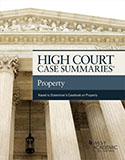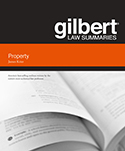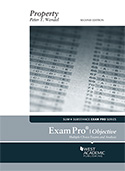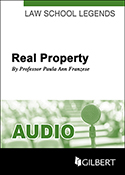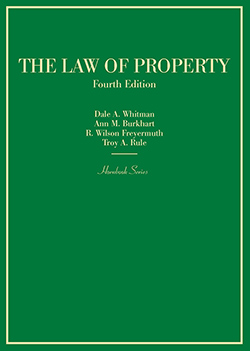
The Law of Property
Authors:
Whitman, Dale A. / Burkhart, Ann M. / Freyermuth, R Wilson / Rule, Troy A.
Edition:
4th
Copyright Date:
2019
16 chapters
have results for real estate
Chapter 6 LANDLORD AND TENANT191 127 results (showing 5 best matches)
- A tenant has an estate in land in the strictest sense. The tenant has the right to possession, the hallmark of every estate. Yet for purely historical reasons, real estate law classified this estate not as a freehold estate, but rather as a non-freehold “chattel real,” a species of personalty.
- Commercial leases (and some long-term residential leases) frequently contain clauses requiring the tenant to pay all or some part of the real estate taxes. Especially in a “net” lease, the tenant may be required to pay all real estate taxes and assessments. A more limited form of the clause requires the tenant to pay tax increases that flow from improvements the tenant makes.
- Thus, the landlord’s underlying estate passes to the landlord’s heirs or devisees subject to the leasehold;
- Real Estate Finance Law §§ 3.26–3.38 (6th ed.2015)
- Real Estate Finance Law §§ 4.24–4.29 (6th ed.2015)
- Open Chapter
Chapter 8 SERVITUDES349 196 results (showing 5 best matches)
- Real covenants run with
- Under the traditional English rule for the running of real covenants, there was no requirement that the successor take the affected estate with notice of the covenant.
- This section corresponds to the discussion of the “vertical privity” requirement for real covenants in Section 8.17. We saw that real covenants run with estates in land;
- The obvious implication of this principle is that one can enforce the burden of a real covenant against a remote party only when that party has succeeded to the covenantor’s estate in the burdened land. Such a party stands in privity of estate—to be precise, vertical privity—with the covenantor.
- Collins v. Metro Real Estate Servs. LLC, 72 N.E.3d 1007 (Ind.App.2017)
- Open Chapter
Chapter 10 CONTRACTS FOR THE SALE OF LAND595 137 results (showing 5 best matches)
- Real Estate Finance Law, §§ 3.26–3.37 (6th ed. 2014)
- An excellent discussion of real estate contract drafting and the wide variety of clauses which should be considered is found in Friedman & Smith, Contracts and Conveyances of Real Property (8th ed. 2017).
- A review of terminology may be helpful here. “Heirs” are the persons who take the decedent’s real estate under the relevant succession statute if he or she dies intestate. If the decedent dies testate as to real estate, it passes to the “devisees” under the will. Personal property passes to “next-of-kin” if the decedent is intestate, or to “legatees” if disposed of by the will.
- Murray, Options and Related Rights with Respect to Real Estate: An Update, 47 Real Prop. Tr. & Est. L.J. 63 (2012)
- It may seem peculiar to include a chapter on contract law in a book about property. Real estate sales contracts are subject to most of the same legal rules that govern other contracts. Offer, acceptance, and consideration are still essential, and the concepts of misconduct or mistake, illegality, and the like also apply.
- Open Chapter
Table of Cases 835 219 results (showing 5 best matches)
- Real Estate Bar Ass’n for Massachusetts, Inc. v. Nat’l Real Estate Info. Servs., 667
- AKG Real Estate, LLC v. Kosterman, 374, 375
- Barash v. Pennsylvania Terminal Real Estate Corp., 226, 227, 228, 230
- Cecil Lawter Real Estate School, Inc. v. Town & Country Shopping Center Co., 806
- Cochran’s Real Estate, In re, 163
- Open Chapter
Chapter 2 Present Estates in Realty and Equivalent Interests in Personalty19 181 results (showing 5 best matches)
- The tenant of an estate for his or her own life obviously has no power to devise the estate by will, because it terminates at the tenant’s death.
- In modern real estate practice, estates in fee simple subject to a condition subsequent are rarely created in commercial transactions, but they are still sometimes created when land is given to charitable, religious, educational, or government entities.
- The widow’s life estate was called “dower,” and the widower’s life estate was called “curtesy.” While both spouses were alive, the husband also enjoyed the right to control and manage all of his wife’s real property
- Statutory abolition or modification of dower and curtesy has everywhere been preceded or accompanied by revision of the intestate succession laws to make a surviving spouse an heir who is entitled to a specified share of the decedent’s estate in fee simple.
- The ejectment action was obviously superior to the real actions available to the tenant of a freehold estate, which soon led freeholders to seek and obtain the right to use ejectment in lieu of the real actions.
- Open Chapter
Chapter 11 CONVEYANCES AND TITLES699 200 results (showing 5 best matches)
- The principal proponent of disclosure statement statutes for residential properties has been the real estate brokerage industry. Brokers have been (understandably) worried about their liability for failure to disclose material facts, and statutes such as this are designed to relieve them of that liability.
- Lefcoe, Property Condition Disclosure Forms: How the Real Estate Industry Eased the Transition from Caveat Emptor to “Seller Tell All”, 39 Real Prop. Prob. & Tr. J. 193 (2004)
- There are two principal types of real estate escrows, and both raise interesting legal issues. One is the commercial or sales escrow,
- No instrument affecting real estate is of any validity against subsequent purchasers for a valuable consideration, without notice, unless filed in the office of the recorder.
- Occasionally controversy develops as to whether a particular instrument is entitled to be recorded. The statutes usually speak in terms of “conveyances of interests in real estate” or similar language. There is no question that any document conveying a legal, as opposed to an equitable, interest is recordable, provided it includes the notarial acknowledgment usually required by statute.
- Open Chapter
Chapter 1 Introduction1 31 results (showing 5 best matches)
- “At common law, a freehold estate of inheritance could be created only by a phrase that included the word ‘heirs’. An attempt to grant a freehold estate in other terms (as ‘to A’, or ‘to A in fee simple’) gave A merely a life estate.” Real Property, supra note 57
- An initial distinction in property law is between real and personal property. Real property in the common law corresponds with immoveable property in the civil law. It includes land and the things attached to it, such as buildings. Real property is also called real estate or realty. In contrast, personal property in the common law corresponds with moveable property in the civil law. Personal property includes chattels and intangible things, such as claims represented by bank accounts, promissory notes, corporate and government bonds, shares of corporate stock, life insurance policies, annuities,
- For a more extended discussion of the evolution of such estates, see 1 Am. L. Prop., supra note 38 , at 15–18; Real Property, supra note 57
- The fee tail, which created rights in the original tenant’s descendants, could not be prejudiced by forfeiture, “gave to landowners what the common law had always denied to them: the power to create a virtually inalienable estate.” Real Property, supra note 57
- If the fee simple estate had been the only possessory real property interest recognized in the period after Quia Emptores, Anglo-American law might have developed along the same lines as the civil law of continental Europe, where property in land was viewed in essentially unitary terms. But recognition of the fee simple as an inheritable interest did not eliminate the possibility of creating life estates. Indeed, the courts not only continued to recognize life estates in land, but also held that a conveyance of land to a natural person without adding the words “and his heirs” or “and the heirs of his body” could only create a life estate.
- Open Chapter
Chapter 3 Future Estates in Realty and Personalty63 139 results (showing 5 best matches)
- A term of years, technically, is personal property—a “chattel real”—and the owner of an estate for years cannot have seisin.
- When the owner of a possessory estate in land transfers the entire estate without providing for defeasance of the estate on the happening of a stated event, no future interest is created.
- Even if a transferor had only a life estate or a fee tail estate before the transfer, transferring less than the entire estate creates a reversion.
- In 1830, New York enacted the first significant statutory modification of the common law Rule Against Perpetuities. The New York legislation prohibited the creation of any future interest that would suspend the absolute power of alienation of real property or “the absolute ownership of personal property” for longer than “two lives in being” when the future interest was created.
- ; 2 H. T. Tiffany & B. Jones, The Law of Real Property and Other Interests in Land § 333 (3d ed. 1939); see also J. C. Gray & R. Gray, The Rule Against Perpetuities § 113.1 (4th ed. 1942). In support of the view that B obtains a vested remainder and C obtains an executory interest, see A. Kales, Estates, Future Interests and Illegal Conditions and Restraints in Illinois § 95 (1920); 1 R. Preston, An Elementary Treatise on Estates, 84, 502 (1820). In support of the view that C and B obtain alternative contingent remainders, see First Restatement of Property, supra note 37
- Open Chapter
Chapter 5 CONCURRENT OWNERSHIP OF REALTY AND PERSONALTY141 98 results (showing 5 best matches)
- Real Estate Finance Law § 1.5 (6th ed. 2015)
- In the early common law, neither a tenancy in common nor a joint tenancy could be created except by inter vivos conveyance. After 1540, either type of concurrent estate
- From an early date, the English common law has recognized that concurrent, as well as several, estates in property can be created. Concurrent estates exist when two or more persons have a concurrent and equal right to possession and use.
- This proof may not be too difficult when a separate asset has been segregated and separately maintained, such as a single parcel of real estate, a block of corporate stock, or a scrupulously segregated bank account.
- Real Estate Finance Law §§ 8.4–8.7 (6th ed. 2015)
- Open Chapter
Chapter 9 GOVERNMENTAL REGULATION OF LAND USE439 25 results (showing 5 best matches)
- The planning commission, typically comprised of seven to nine members, is appointed by the local legislative body. It is essentially an administrative body that exists to make recommendations to the local legislative body for ordinances. Planning commissioners are not professional planners like the planning department or planning firms. In most localities, their members are citizens who have some familiarity with real estate such as architects, engineers, officers of lending institutions, real estate brokers, an occasional lawyer, and perhaps an ordinary homeowner or two for balance. They are citizen volunteers, usually unpaid, who meet perhaps once or twice a month. Though the commission is a separate entity from the legislative body, its functions are similar to those that might be performed by a committee of that body. Like the SZEA’s zoning commission, the planning commission generally conducts studies, holds hearings, and recommends the original zoning ordinances to the...
- Meanwhile, because of disrupted plans, loss of financing, or perhaps changes in the real estate market, the owner’s project may well have become infeasible by that time. On the other hand, if, after several years of administrative procedures and litigation, the governmental entity must pay compensation to one or more landowners, then the entity suffers a real penalty for miscalculating the legal effect of its regulation that can have a powerful deterring effect. The possibility of compensation also gives the plaintiff landowner more bargaining leverage than if the only available remedy were invalidation.
- These famous words by Blackstone are not true today and were not true when written. Blackstone’s words have to be understood in a special sense, referring to the pure concept of “property.” Of course he knew well, as we know today, that there are many legal limitations upon the actual use and enjoyment of property rights in land. Many of these limitations have been highlighted in prior chapters of this treatise. The doctrines of nuisance, of lateral support, and of the sharing of riparian rights are examples of constraints the law imposes on landowners. Many owners have voluntarily limited their ownership rights, for instance, by granting easements or profits or by fragmenting their ownership into present and future estates, including leaseholds. Persons who choose thus to fragment ownership invoke special limitations on the estates they create; the rules against waste and much of the law of landlord and tenant are examples. Our rigid system of estates limits the permissible forms...
- interests in real or personal property by eminent domain, they literally compel a private owner to transfer those interests to them. In England this is called “compulsory purchase” or “appropriation.” American law calls it by its Continental civil law name, “eminent domain.” In most instances, the property interests taken through exercises of eminent domain authority are fee simple title or some lesser real property interest such as an easement or leasehold. For example, a state transportation department might exercise its eminent domain power to “condemn” or take title to specific tracts of land for use in building a new public highway. Such condemnations of land are effectuated through an actual conveyance of the interest from the landowner to the governmental entity, just as if the owner had given a deed. In fact, governmental entities and landowners often opt to avoid potentially costly condemnation actions by using a deed or other instrument to voluntarily convey the property...
- Payne, Exclusionary Zoning and the “Chester Doctrine,” 20 Real Est.L.J. 366, at 327 (1992)
- Open Chapter
Chapter 4 Relations Between Owners of Present and Future Estates and Interests119 60 results (showing 5 best matches)
- A life tenant has a duty to pay all special assessments levied against the property for public improvements if their estimated life does not exceed the life estate’s probable duration.
- Any estate of indefinite duration, such as a life estate, carries with it the right of “emblements,” which permits the possessor to harvest and remove, after the termination of her estate, any crops that she planted.
- When the rental income or rental value is insufficient to cover the carrying charges, the future interest owner may pay them in full and then sue the possessor for reimbursement and a lien for the amount that she is entitled. The lien will be enforced by an order for sale of the possessory estate. See supra §§ 4.3, 4.4, 4.6. However, selling the entire fee simple estate may be a better solution for the future interest owners because it requires no financial outlay by them and because life estates are not readily salable.
- and the interest periodically accruing on any mortgage or similar consensual encumbrance that constituted a lien on the fee simple estate when the life estate was created.
- Judicial Sale of Realty Encumbered by Future Estates.
- Open Chapter
Index 921 40 results (showing 5 best matches)
Table of Contents 19 results (showing 5 best matches)
- Turning now to the subject of subjacent support: it was defined at the beginning of this section as a right to have one’s land supported “in a horizontal plane from underlying strata of earth owned and occupied by other persons.” This generally implies a severance of one or more estates in layers of underlying earth from the estate in the surface, with the underlying layers being owned, occupied, or used by others than the holder of the surface estate. Potential defendants are thus necessarily limited to such underlying owners or users, and potential plaintiffs are limited to the possessor of the surface or of some layer above the defendant. An exception, in some jurisdictions, exists in cases in which a neighbor removes underground water in such quantities as to drain the water from under the plaintiff’s land and to cause the plaintiff’s land to subside. The Restatement of Torts, Second, some text writers, and some decisions take the position that the neighbor in that instance...
- For that reason, lateral support, as a real property right, probably does not extend to a right of support from nonadjacent lands.
- (discussing the link between the tort of public nuisance and real property).
- (explaining that the starting point of all property law is that “a parcel of land includes all interests and estates therein from the center of the earth to the heavens.”)
- Open Chapter
Summary of Contents 3 results
Preface iii 3 results
- We have divided the work on this edition in the following way. Ann Burkhart of the University of Minnesota prepared the first five chapters, which deal with estates, future interests, and concurrent ownership. Wilson Freyermuth of the University of Missouri was responsible for Chapters 6 and 8, dealing with landlord-tenant law and servitudes. Troy Rule of Arizona State University wrote Chapter 7 on rights incident to possession of land and Chapter 9 on land use controls. Dale Whitman, now an emeritus faculty member at the University of Missouri, prepared Chapters 10 and 11, which deal with conveyancing and titles.
- This book is about the American system of property law, but our law is descended from England. It began shortly after the Norman conquest of 1066, and English history still exerts a surprisingly strong influence on our system. The principles of property law comprise a very large subject. Anyone familiar with the workings of lawyers’ minds and pens must know that nearly a thousand years of development will produce a prodigious body of law! Within one volume of hornbook size, this book surveys the chief areas and more: history and basic concepts; estates in land, present, future, and concurrent; comparable interests in personalty; landlord and tenant law; rights against neighbors and other third persons; easements and profits; running covenants; governmental controls on land use; land contracts; conveyances; titles; and recording systems.
- ...s history. This is its fourth edition. Work on the first edition began in 1980 and it was published in 1984. Two of its three authors are now deceased. Roger A. Cunningham was the first to conceive of the book. Roger was born in Paxton, Illinois in 1921. He graduated from Harvard College in 1942 and Harvard Law School in 1948, practiced briefly in Boston, and then became a law teacher, first at George Washington University and then at Rutgers University, before joining the University of Michigan law faculty in 1959. He remained there for the rest of his academic career. Roger was a meticulous scholar with interests in all aspects of property law, but was perhaps best known for his work in land use planning law. He was responsible for the roots of the careful and thoughtful explication of estates in land and future interests that appears in all editions of this book, including the present one. Roger was a coauthor of both the first and second editions of this book. The second...
- Open Chapter
- Publication Date: January 22nd, 2019
- ISBN: 9781640202375
- Subject: Property
- Series: Hornbooks
- Type: Hornbook Treatises
- Description: Trustworthy and modern source on property laws surveys estates in land—present, future, and concurrent, comparable interests in personalty, landlord and tenant law, and rights against neighbors and other third persons. Also examines easements and profits, running covenants, governmental controls on land use, land contracts, conveyances, titles, and recording systems. Contains footnote citations to leading court decisions for easy location of primary authority.
